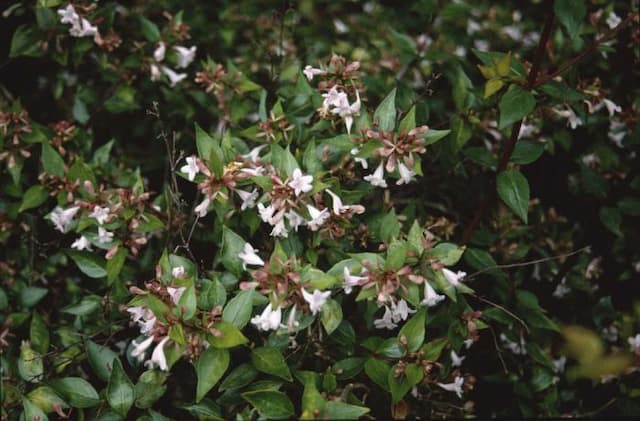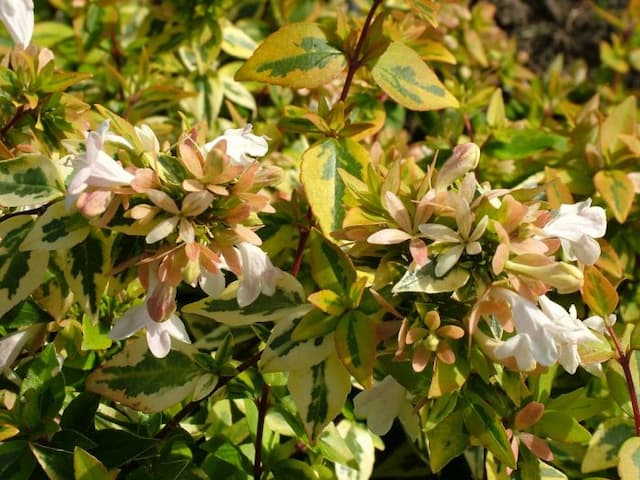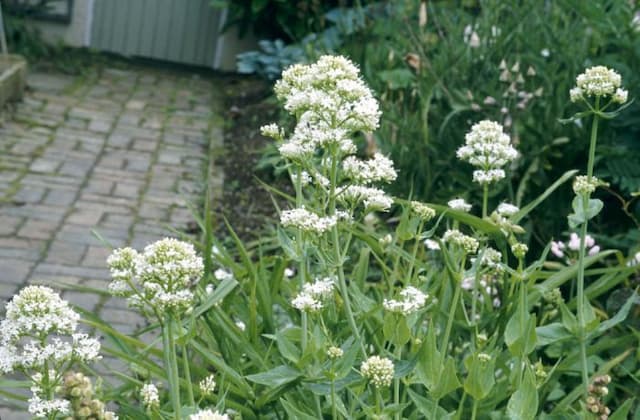Glossy Abelia Abelia × grandiflora 'Sparkling Silver' (v)

ABOUT
The Abelia 'Sparkling Silver' is a charming shrub that captivates with its foliage and blossoms. Its leaves are a delightful mix of green and white, with the green predominating in the center and a striking white variegation creating a beautiful contrast along the edges of each leaf. This variegation gives the appearance of the leaves sparkling, hence the name 'Sparkling Silver'. The flowers that bloom on this plant are tubular and small, typically in clusters, with a soft pink to white hue that adds a delicate and romantic touch to the shrub. The overall impression is of a light and variegated foliage accented by gentle floral hues, making it an attractive plant for ornamental use in a variety of garden settings.
About this plant
 Names
NamesFamily
Caprifoliaceae
Synonyms
Glossy Abelia, Sparkling Silver Abelia
Common names
Abelia × grandiflora 'Sparkling Silver' (v).
 Toxicity
ToxicityTo humans
Glossy Abelia is not known to be toxic to humans. There are no widely recognized symptoms of poisoning from ingesting this plant as it is generally considered non-toxic.
To pets
Glossy Abelia is not known to be toxic to pets. It is not associated with any specific symptoms of poisoning, as it is generally recognized as a non-toxic plant to both dogs and cats.
 Characteristics
CharacteristicsLife cycle
Perennials
Foliage type
Semi-deciduous
Color of leaves
Variegated
Flower color
White
Height
3-6 feet (0.9-1.8 meters)
Spread
3-6 feet (0.9-1.8 meters)
Plant type
Shrub
Hardiness zones
6
Native area
Hybrid
Benefits
 General Benefits
General Benefits- Aesthetic Appeal: The 'Sparkling Silver' variety of Glossy Abelia has variegated foliage with silver margins and white flecks, coupled with pink-blushed, white flowers, adding visual interest to gardens.
- Attracts Wildlife: It is known to attract pollinators such as bees, butterflies, and hummingbirds, enhancing biodiversity.
- Drought Tolerance: Once established, this plant has a good level of drought resistance, reducing the need for frequent watering.
- Low Maintenance: Glossy Abelia is generally easy to care for and requires minimal maintenance, making it suitable for a variety of landscapes.
- Versatility: It can be used in various garden designs, including as a border shrub, foundation planting, or as part of a hedgerow.
- Seasonal Interest: It provides year-round interest with its evergreen to semi-evergreen nature in mild climates and has a long blooming period from summer into fall.
- Compact Growth: This cultivar usually remains compact, making it ideal for small gardens or spaces with limited room.
- Pruning Tolerance: It can be easily pruned and shaped to maintain a desired size or structure.
- Deer Resistant: This plant is relatively resistant to deer, reducing the likelihood of damage in areas with deer populations.
 Medical Properties
Medical PropertiesThis plant is not used for medical purposes.
 Air-purifying Qualities
Air-purifying QualitiesThis plant is not specifically known for air purifying qualities.
 Other Uses
Other Uses- Photographic Subject: Abelia 'Sparkling Silver' can be an excellent subject for photographers due to its variegated silver and green foliage, which contrasts nicely with the delicate pink-tinged flowers.
- Inspiration for Artists: The unique coloration of the foliage and flowers of the Abelia 'Sparkling Silver' can be used by artists as inspiration for color palettes and textures in their artwork.
- Culinary Garnish: While not commonly used, the flowers of the Abelia 'Sparkling Silver' can be used as an ornamental garnish for certain dishes to add unexpected beauty.
- Educational Tool: Gardeners and educators can use the Abelia 'Sparkling Silver' to teach about variegation in plants, as well as techniques for breeding and hybridization.
- Craft Projects: Dried leaves and flowers of the Abelia 'Sparkling Silver' can be incorporated into craft projects, such as making bookmarks or pressed flower arrangements.
- Living Sculptures: With its dense foliage, the Abelia 'Sparkling Silver' can be trained and trimmed into topiary shapes, making it a living element of sculptural art in the garden.
- Theme Gardens: This plant can be a key element in a silver-themed garden or a moonlight garden, where its foliage can reflect moonlight and create a captivating ambiance.
- Erosion Control: When planted on slopes, the Abelia 'Sparkling Silver' can help stabilize soil and prevent erosion with its root system.
- Privacy Screen: When planted in groups, the Abelia 'Sparkling Silver' can create a low-maintenance, decorative privacy screen for home gardens.
- Seasonal Decoration: Branches of Abelia 'Sparkling Silver' can be cut and used to add an elegant touch to fall and winter floral arrangements and wreaths.
Interesting Facts
 Feng Shui
Feng ShuiThe Glossy Abelia is not used in Feng Shui practice.
 Zodiac Sign Compitability
Zodiac Sign CompitabilityThe Glossy Abelia is not used in astrology practice.
 Plant Symbolism
Plant Symbolism- Beauty: The 'Sparkling Silver' Abelia's ornamental leaves and showy flowers are associated with beauty and admired for their aesthetic appeal.
- Resilience: Abelias are known for their hardiness and ability to thrive in various conditions, symbolizing resilience and adaptability.
- Renewal: The plant's ability to flower for a long season represents renewal and the continuous cycle of growth.
- Attraction: With its fragrant and vibrant blooms, the Abelia attracts pollinators, symbolizing attraction and allure.
 Water
WaterGlossy Abelia 'Sparkling Silver' requires regular watering to maintain its health and promote growth, especially during its first growing season to establish a deep, extensive root system. Once established, reduce frequency, but keep in mind that they prefer consistent moisture. Generally, watering should be deep enough to saturate the root zone, with about 1 gallon per week being sufficient for an established plant, depending on weather conditions. During periods of drought or extreme heat, increase the amount slightly to counter the increased rate of evaporation. It's important to avoid overwatering as well, as this can lead to root rot.
 Light
LightGlossy Abelia 'Sparkling Silver' thrives best in full sun to partial shade. Ideally, it should receive at least 6 hours of direct sunlight per day. A spot that offers morning sunlight with some afternoon shade would be perfect to protect it from the more intense afternoon heat, especially in hotter climate zones.
 Temperature
TemperatureGlossy Abelia 'Sparkling Silver' is quite hardy and can tolerate a wide range of temperatures. It generally prefers temperatures between 60°F to 90°F for optimal growth. It can survive minimum temperatures down to about 5°F but may suffer foliage damage. Ideally, ensure that it is not exposed to prolonged temperatures in the extremes of its range to keep it healthy.
 Pruning
PruningGlossy Abelia 'Sparkling Silver' can be pruned to maintain shape and encourage bushier growth. Pruning should be done after the plant has finished blooming, generally in late winter or early spring before new growth begins. Cut back up to one-third of the oldest stems to ground level to promote new growth and a more vigorous plant. The best time to prune is when the plant is dormant, to minimize stress on the plant.
 Cleaning
CleaningAs needed
 Soil
SoilGlossy Abelia prefers well-draining, loamy soil with a pH ranging from 5.5 to 7.5. A good mix would be two parts garden soil, one part sand, and one part organic compost or peat moss to promote drainage and fertility.
 Repotting
RepottingGlossy Abelia typically doesn't require frequent repotting; it should be done every 2-3 years or when the plant has outgrown its current pot or the soil has become compacted.
 Humidity & Misting
Humidity & MistingGlossy Abelia thrives in average humidity levels; it does not require any special humidity conditions and can tolerate the humidity found in most temperate climates.
 Suitable locations
Suitable locationsIndoor
Place in bright, indirect light, and ensure good air circulation.
Outdoor
Plant in sun to part shade with shelter from harsh winds.
Hardiness zone
6-9 USDA
 Life cycle
Life cycleThe life of Abelia 'Sparkling Silver', a hybrid ornamental shrub, initiates with seed germination, although this cultivar is more commonly propagated through semi-hardwood cuttings. Once rooted, the young plant enters a juvenile growth phase where it establishes a strong root system and begins to produce its characteristic variegated foliage and arching branches. As it matures, it enters the flowering stage in late spring to early summer, where clusters of small, fragrant, tubular flowers bloom, attracting pollinators. Following pollination, if conditions allow, it may produce small, inconspicuous seeds, though propagation by seeds is less common for cultivars. The plant will then undergo a period of dormancy in colder climates during winter, where growth slows and it may drop some leaves depending on the severity of the weather. With the return of warmer temperatures in the spring, the cycle recommences with new growth of leaves and stems, and the plant continues to mature, typically reaching its full size and shape after several growing seasons.
 Propogation
PropogationPropogation time
Spring-Early Summer
Propogation: The most popular method of propagating Abelia × grandiflora 'Sparkling Silver', commonly known as Glossy Abelia, is through semi-hardwood cuttings. This is typically done during the late summer months, from July to September. To propagate, you would cut a healthy 4 to 6-inch (10 to 15 cm) stem section just below a leaf node, where the stem is beginning to mature and harden but is not yet fully woody. Strip the leaves from the lower half of the cutting and dip the cut end into a rooting hormone to encourage root growth. Then, plant the cutting in a well-draining soil mix, ensuring the leafless portion is buried and the remaining leaves are above the soil. The cutting should be kept moist and in a warm place with indirect light until roots have developed, which usually occurs within a few weeks.









